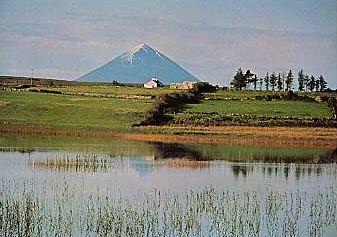At
Ballycastle on the north coast are the remains of Stone Age field
walls dating from 3000 B C these are among the largest in the
world. Later remains include those of monasteries from Celtic
times, and from the Middle Ages. of Stone Age field
walls dating from 3000 B C these are among the largest in the
world. Later remains include those of monasteries from Celtic
times, and from the Middle Ages.
In early times Mayo was ruled by the O'Connors.
After the Anglo-Norman invasion in the 1100's, lands were granted
to the de Burgos, an Anglo-Norman family.
Mayo did not come under firm British control
until the 1600's. Mayo was one of the counties most severely affected
by the Great Famine in the 1840's, when nearly a third of the
population died or emigrated. The population continued to decline,
and is now only about two-fifths of the population it had in 1850.
Michael Davitt, leader of the land struggle of the late 1800's,
was born.
Croagh Patrick is an isolated mountain
rising to about 760 meters (2,460
Ft) above sea level in County Mayo. Irish Roman Catholics regard
it as a holy mountain because St.
Patrick is said to have spent 40 days in prayer and fasting
on its summit, praying for the success of his mission in Ireland.
Patrick, who became the patron saint of Ireland, was chiefly responsible
for converting the Irish people to Christianity. |


